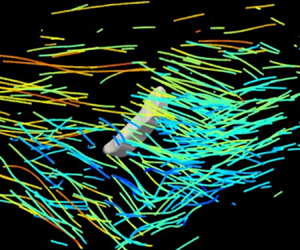Article contents
The orientational dynamics of deformable finite-sized bubbles in turbulence
Published online by Cambridge University Press: 19 March 2021
Abstract

We present simultaneous three-dimensional measurements of deformable finite-sized bubbles and surrounding turbulent flows. The orientations of bubbles are linked to two key mechanisms that drive bubble deformation: the turbulent strain rate and slip velocity between the two phases. The strongest preferential alignment is between the bubbles and slip velocity, indicating the latter plays a dominant role. We also compared our experimental results with the deformation of ideal material elements with no slip velocity or surface tension. Without these, material elements show highly different orientations, further confirming the importance of the slip velocity in the bubble orientation. In addition to deformation, when bubbles begin to break, their relative orientations change significantly. Although the alignment of the severely deformed bubbles with the eigenvectors of the turbulent strain rate becomes much stronger, the bubble semi-major axis becomes aligned with (rather than perpendicular to) the slip velocity through an almost  $90^{\circ }$ turn. This puzzling orientation change occurs because the slip velocity contains the contributions from both the bubble and the background flow. As the bubble experiences strong deformation, the rapid elongation of its semi-major axis leads to a large bubble velocity, which dominates the slip velocity and forces its alignment with the bubble's semi-major axis. The slip velocity thereby switches from a driving mechanism to a driven result as bubbles approach breakup. The results highlight the complex coupling between the bubble orientation and the surrounding flow, which should be included when modelling the bubble deformation and breakup in turbulence.
$90^{\circ }$ turn. This puzzling orientation change occurs because the slip velocity contains the contributions from both the bubble and the background flow. As the bubble experiences strong deformation, the rapid elongation of its semi-major axis leads to a large bubble velocity, which dominates the slip velocity and forces its alignment with the bubble's semi-major axis. The slip velocity thereby switches from a driving mechanism to a driven result as bubbles approach breakup. The results highlight the complex coupling between the bubble orientation and the surrounding flow, which should be included when modelling the bubble deformation and breakup in turbulence.
- Type
- JFM Papers
- Information
- Copyright
- © The Author(s), 2021. Published by Cambridge University Press
References
REFERENCES
- 10
- Cited by



